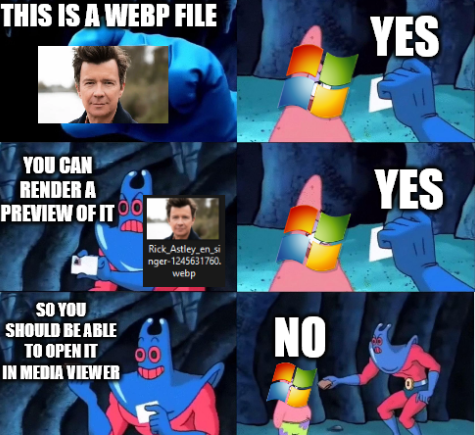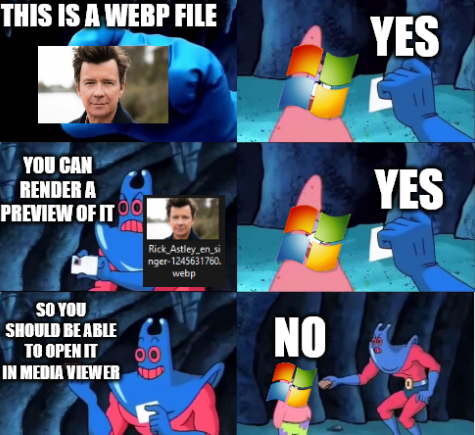I know nothing about computers but this does not add up
-
I do expect it to be a matter of time. Typically, you pull some image rendering library into your program, which pulls in a whole bunch of libraries that support the different image formats.
As such, it's the job of that intermediary library to support as many formats as possible. If you keep that intermediary library up-to-date, you may get support for new image formats without really doing anything.But well, it may take more time for this to happen, for various reasons. One reason is obviously that we already have other image formats that may not be amazing, but they work everywhere, so most people continue to use those.
Another aspect that may slow adoption down, is that .webp was spear-headed by Google alone. Normally, you get other industry leaders into the boat, to make sure you cover everyone's use-cases and have somewhat of a commitment for them to integrate it. I assume that Photoshop supports .webp by now, but it probably took relatively long for that to happen, for example.Superb explanation. Many thanks for the insight Ephera!
-
avif is better than it in almost all ways, and jpex xl is even better than that (but not about gifs i think)
webp is essentially a webm file (which is mkv with codec restrictions(vp8/9 and ogg vorbis or opus))
avif is av1 encoded files in a webp like container (but not webm afaik)
jpeg xl is a format made specifically for images
AV1 is only supported by new devices, most support VP9. For example, the iPad Air 2024 does not support AV1.
-
AV1 is only supported by new devices, most support VP9. For example, the iPad Air 2024 does not support AV1.
yes, but that is a bit apple specific, and on intel side, they support hwdec since 2021. and since these are just images, even software decoding works (although a bit slower)
-
I work in big tech and this is my life. I envy anyone who thinks you're exaggerating, because that means they haven't experienced the joy of spending weeks trying to track down the team responsible for a bug and then months hassling them to fix it.
Oh, man.
I just stopped being hassled to fix a bug on somebody else's system (that mine interops with), by the same developers responsible for maintaining that other system, because the problem got bad enough to escalate until somebody responsible for both sides looked.
That said, I was just ignoring them. But hell...
-
okay. it is a lot simplified, but mostly correct. ideally image format for drawn out stuff and other flat animated stuff is svg (vector graphics - ie - infinitely scalable yet crisp), but png is usually used because it is defacto lossless standrad. lossless here roughly translates to - sensor produced a matrix of colors - lossless photo preserves all data. lossy discards some data. For irl stuff, usually lossless is overkill for end user, hence you see jpegs (defacto lossy standrad)
jxl can so both. others can do that as well. jpegs can be lossless, but that is usually not the standard we use. you can store lossy data in pngs, but the loss is not created by png. jxl behaves by default like lossless (like png), but due to newer algorithms, size when lossless is closer to jpeg. if you prepare loss jxl - it can be close to half size of jpegs.
there are other benifits to jxl (extreme future proofing (extremely high bit depth, and pixel size limit, large amount of channels), progressive decoding, etc.), but our reality has to suck because of google.
I locally use jxl to store family photos, but this means i can not send them, because they are using stuff which does not support jxl, so have to convert and share.
I think gif is also better than jpg for the low-complexity images and is lossy so the file size gets even smaller. Or so I've heard.
-
wrote last edited by [email protected]
Sounds like windows people sticking to bmp images back when it was all it would support.
-
avif is better than it in almost all ways, and jpex xl is even better than that (but not about gifs i think)
webp is essentially a webm file (which is mkv with codec restrictions(vp8/9 and ogg vorbis or opus))
avif is av1 encoded files in a webp like container (but not webm afaik)
jpeg xl is a format made specifically for images
jpeg xl has even less default support tho unless you use a mac
-
I loathe windows, but I did just double check because this sounds inept even for M$ -- Win photos will absolutely open .webp, but it's not the default program for whatever reason and it just defaults to edge /
your_default_web_browser_here. Which is just impressively on brand for microsoft. Even when they have a feature they hide it to, idk, make themselves look even worse? Why not!::: spoiler proof

:::(FWIW this is a clean install, I do not have any non-default codecs installed)
Yeah, it's sorted through WIC iirc. As long as you have the codec installed you should be able to open it.
-
This post did not contain any content.
I know a bunch about computers and that doesn't add up to me either!! I hate the webp format.
-
Time to screenshot the preview and stretch out the jpeg. Upload it when the time calls, only for the web server to re-encode it in webp. The cycle continues.
I do this regularly now.
-
This is MS we're talking about. Preview and Viewer are probably made by two different teams in different countries, sharing no code, and prohibited from communicating with each other, even if they know about the other's existence.
And famously they fired all QAs years ago so there's nobody to test before releasing.
The image viewer is probably just Edge in a trenchcoat by now.
-
I loathe windows, but I did just double check because this sounds inept even for M$ -- Win photos will absolutely open .webp, but it's not the default program for whatever reason and it just defaults to edge /
your_default_web_browser_here. Which is just impressively on brand for microsoft. Even when they have a feature they hide it to, idk, make themselves look even worse? Why not!::: spoiler proof

:::(FWIW this is a clean install, I do not have any non-default codecs installed)
real reason is that microsoft doesn't want to pay $0.50 in licensing fees from some patent trolls
-
Webp is the worst format ever.
Never mind that:
- it supports transparency;
- it can be losslessly OR lossfully compressed;
- it's so efficient it can fit ẏ̷̛̀̏̎̇͜ǫ̷̼̰̳̹́̆̍̐͜͝ủ̷͉̱̻̤̬̯̈́ŗ̸̒ ̸̨̟͈̳͍̱̀̏̓m̵̺͎̋́u̴͇̥͍͐̇̀̇͊̌̚͝m̸̢̢͕̻̬͙̒͗̽͋͆̕͝ in less than 2GB;
- it can be animated;
- is more than capable of representing 1:1 any GIF image;
it sucks because the one image viewer I've ever had installed by the ubiquitous (= monopolistic) operating system everyone has by default doesn't support it.
I just converted all the images on my website to webp for faster load time.
Very happy with it. -
real reason is that microsoft doesn't want to pay $0.50 in licensing fees from some patent trolls
is webp patented? good I hate IP laws
-
This post did not contain any content.
I didn't have time to check all the comments, so here's a backup:
Just install GNU/Linux

-
jpeg xl has even less default support tho unless you use a mac
that is indeed the sad truth
-
I think gif is also better than jpg for the low-complexity images and is lossy so the file size gets even smaller. Or so I've heard.
this is true, but gifs had some other license related issues early on so did it was behind jpeg. now jpeg has momentum far superior to anythinng else
-
Can webp keep transparency?

It’s very flexible and supports everything:
- transparency
- video
- lossless
It’s lighter weight than other file formats.
The only downside is that it’s not supported by a lot of apps and websites (e.g. Instagram)
-
This post did not contain any content.
Media viewer and the file browser are completely different programs with different support for media file types.
Not that this is an excuse for Media Viewer to not open webp files. Also asking you to pay for h265 support is extra ridiculous.
I just use VLC for everything.
-
yes, but that is a bit apple specific, and on intel side, they support hwdec since 2021. and since these are just images, even software decoding works (although a bit slower)
wrote last edited by [email protected]I’d say 2021 is still pretty damn recent, most of my computing devices are still pre 2020. It’s also not just Apple, for example the latest Fairphone 6 doesn’t support it either. Images can still be pretty damn big when taken from a high resolution camera, and software decoding defeats the benefit from a format that’s supposed to be efficient. I’d say that it will probably take another decade for avif to become mainstream.





